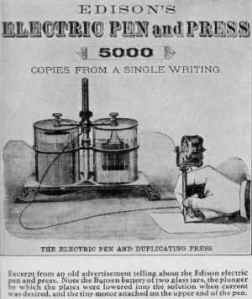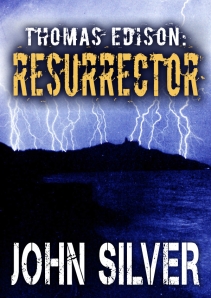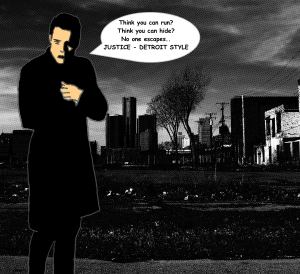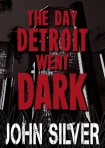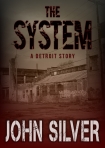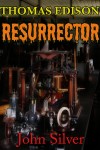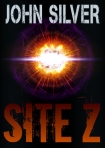Thomas Edison: RESURRECTOR Free Download
Thomas Edison: RESURRECTOR will be a free download tomorrow (July 1, 2012) on Amazon.com.
Get it here: http://www.amazon.com/Thomas-Edison-RESURRECTOR-ebook/dp/B008BB99FW/ref=sr_1_1?ie=UTF8&qid=1339708745&sr=8-1
Thinking Outside the Can
This post was first published on the USIPNow.com blog and was focused on inventors and the process of invention. It also applies to creative writing and filmmaking. Here’s the take away: is there something critical missing in your current project?
How do you feed an army? Supplying the military was one of the main factors behind the invention of canned foods. This pioneering innovation can be traced to the early days of the Napoleonic Wars, spanning from 1803 to 1815. Incentivized by Napoleon, a Frenchman named Nicolas Appert invented one of the earliest canning methods still employed today- persevering food in glass jars. This process was clearly novel and innovative, but early glass jars did not hold up well during transportation or on a battlefield. Lack of food was a key to Napoleon’s 1812 defeat in Russia. Soldiers on the front lines were given priority and meagerly supplied, but those in the rear starved or died from diseases contracted by drinking filthy water and eating rotten or poisonous foraged food. Metal cans, yet to be mass produced and rarely available, could only be opened with bayonets.
Shift now from the bleak, frozen battlefields of Russia to the hustle and bustle of London, England in the Georgian Era. In 1810 Peter Durand, nestled in the heart of sooty industrial London, invented and patented a metal can for preserving food. Durand sold his patent for a thousand pounds to two British entrepreneurs who opened the first canning factory in 1813. The first factory produced six cans an hour. In 1846 new canning machinery was invented that increased production from six cans an hour to sixty.
Guess what—no one invented a can opener.
The can opener was invented by the Waterbury, Connecticut native Ezra Warner in 1858, almost fifty years later. Fifty years! The simple manual can opener still in use today was invented in 1870, and the pull-top can was invented in 1959. It took nearly 149 years to conveniently open a metal can by hand.
Durand and those who followed clearly focused on preserving food and the sanitary constraints that process imposed. The inventor did not consider or contemplate innovative opening means since common tools to do the job already existed; a hammer and chisel (or bayonet). This is a sharply focused example of non-systemic thinking. The inventor directed his creative energy toward a singular inventive context which severely limited the intellectual property protection that could have possibly been afforded. This is a pitfall that many inventors, even today, fall into. Sure, a new invention and a newly issued patent defines a useful innovation, but have all inventive aspects and points of view been accounted for?
It’s all a matter of perspective and point of view. Durand clearly took the point of view of the can and hygienically sealing in food. From the point of view of the food, were there novel aspects of preparing and processing the food before it was sealed in a can? From the point of view of apparatus, was there novelty in machinery that produced cans of different shapes and sizes? Are cans labeled via a paper wrapper or stenciled with paint? What specialized and potentially novel equipment was required for that? From the all important consumer’s perspective, how is a can conveniently opened?
Durand ignored one key insight that is inherent in many inventions: what new problems did his invention create? Imagine someone marooned on a tiny desert island with a crate of canned food. Without materials to fashion a can opener, the poor soul would starve to death.
It seems clear the inventor did not think about all of the contexts and perspectives to couch his invention. If he did, they might have been just passing thoughts—and lost opportunities.
What if the Wright Brothers thought more systemically about their “aeroplane”? Their minds were firmly focused on solving a deep seated heavier-than-air flying machine problem: lateral control. They ingeniously solved it (and got a patent for it). A plane needs to take off and land. Could they have protected the notion of an east-west runway, oriented so aircraft can take off and land facing prevailing winds? Could they have protected for a control tower and signaling mechanism that coordinated take offs and landings? What about the machinery and methods for producing propellers, fuselages and landing gear? The list could go on and on.
Two great lessons are gleaned from the invention of the metal can and can opener.
1) Couch an invention in different points of view and related components. A simple example is a Phillips screw. It’s worthless without a Phillips screwdriver. Writers and filmmakers: are there any missing components in your story, script or novel?
2) What new problems (translate problems to challenges to opportunities) does a new invention create? Writers and filmmakers: are there new sequel and/or spin-off opportunities spawned from your current project?
If Peter Durand would have thought along these lines, he may well have been awarded a number of additional significant patents. And who knows, with a good opener and a ready supply of canned foods, Napoleon might have fed his army, defeated Russia, and changed the course of history.
Edison’s Electric Pen
Here’s Edison’s electric pen that Dr. Charles Brunson modified and used on Evelyn Barker in Thomas Edison: RESURRECTOR.
Brunson’s pen was modified to probe areas of the brain, specifically pain and pleasure areas. Edison was shocked that his invention was used for such dark purposes. Brunson uses the pen on Evelyn in the chapter, The House on Ridge Avenue and Notebook #10.
Edison’s electric pen was a commercial flop but it found new life as the go to device for tattoos.
Lawrence’s Cyclotron
I’ll be posting some cool nerdy stuff tech from the past on this blog during the research phase for the new novel SITE Z. The story takes place during World War II and revolves around super-weapon development, including the uranium bomb. One of the early problems to overcome was efficiently separating U235 from U238. Ernest O. Lawrence patented (although Leo Slizard invented) a cyclotron in 1934. Lawrence was a physicist at the Berkley Radiation Laboratory at the University of California.
A cyclotron accelerates charged particles from the center outward in a spiral trajectory, held within the cyclotron by a magnetic field. The particles are accelerated by a pulsed electric field. Check out the figure below from Lawrence’s 1934 patent to see how it works.
Looking at Fig. 1, components 1 and 2 are electrodes and are ‘semicylindrical hollow plates’ closed on the outer diameter but open facing each other. Component 4 is a high frequency oscillator that produces a pulsating electric field to accelerate the ions. Ions or electrically charged particles are inserted into the space between the two electrodes 1 and 2. this is where the pulsating electric field is concentrated. The ions accelerate and spiral outward and are held in check by the magnetic field provided by magnets (Fig 2, component 3), unless they are allowed to eject from the cyclotron. Look at the bottom left of Fig. 1 where there’s an arrow pointing out of electrode 2 and labeled High Speed Ions.
One of the cool things about cyclotrons are relativistic considerations. As ions approach the speed of light their mass increases. In the early cyclotron shown here the frequency of the pulsating electric field is held constant.
This is a clever machine and Lawrence was convinced that a device based on its principles could separate U235 from U238 and provide fissionable material for a bomb.
References for New Novel
My next novel, as yet untitled, will be about The Manhattan Project, Nazi spies, a young physicist, and alternative technology superweapons, all set during World War II. Here are some of the books I’m reading for context and reference:
The Rise and Fall of the Third Reich – William Shirer
The Manhattan Project – Cynthia Kelly
My Inventions – Nikola Tesla
“Surely You’re Joking, Mr. Feynman” – Richard Feynman
The First Pile – Corbin Allardice
Auschwitz – Miklos Nyiszli
Genius – James Gleick
The Manhattan Project – F.G. Gosling
The Men Who Killed the Luftwaffe – Jay Stout
Thomas Edison: RESURRECTOR Free Download on June 17th
Thomas Edison: RESURRECTOR is a free download today on Amazon.com. Here’s the link to the eBook:
Historical Characters in Thomas Edison: RESURRECTOR
Here’s a list of the historical characters that appear or are mentioned in Thomas Edison: RESURRECTOR
Thomas Edison – Inventor
Henry Ford – Industrialist
John Jacob Astor – Financier
Andrew Carnegie – Steel magnate
George Westinghouse – Industrialist
Harry Houdini – Illusionist
P.T. Barnum – Promoter
Ulysses S. Grant – General and President
Albert Einstein – Physicist
Nikola Tesla – Inventor
J.P. Morgan – Financier
Alessandro Volta – Physicist
William Kemmler – Convicted murderer
Charles Durston – Warden of Auburn Prison
T.E. Roosevelt – President and adventurer
William Rontgen – Physicist
Sarah Jordan – Proprietress
Topsy the Elephant – Electrocution victim
John Wilkes Booth – Assassin
Arthur Dendy – Professor of biology
Clarence Dally – Menlo Park experimenter
Johnny DeBella – Philanderer
Albert Khan – Detroit based architect
Sir Walter Drake – Profiteer
Salon Tatin – Aircraft designer
Louis Paulhan – Aircraft designer
Thomas Edison: RESURRECTOR Released
Thomas Edison: RESURRECTOR was released on Amazon.com last night. I’d like to thank all my friends for their warm support.
Here’s the advertising teaser:
An electrocution…
A otherworldly voice on an early recording…
A psychic engineer…
A murdered heiress…
A secret lab hiding machinery to resurrect the dead…
A modern day practitioner of ancient Egyptian black magic…
The plan is in place, but something goes horribly wrong…
It starts with a strange voice on an early recording. Realizing the voice comes from the spirit world Thomas Edison builds a communication device called the Dead Phone, and it works. Edison reasons that if can communicate with the dead, why not bring them back? With the help of a young psychic engineer Edison builds a Resurrection Tube and Transfer Machine that reanimates fresh corpses and transfers spirits into their newly restored bodies. Meanwhile a modern-day practitioner of Egyptian black magic waits to extract his revenge and restore an evil Egyptian god to life…and let chaos reign over the Earth.
Unleash the Underworld with Thomas Edison in
Thomas Edison: RESURRECTOR
Thomas Edison: RESURRECTOR First Chapter
The first chapter of Thomas Edison: RESURRECTOR is posted on the John Silver Books website. Here’s the URL: http://johnsilverbooks.com/?page_id=61
-
Archives
- March 2015 (1)
- January 2015 (1)
- December 2014 (6)
- November 2014 (2)
- October 2014 (4)
- September 2014 (2)
- August 2014 (1)
- April 2014 (1)
- March 2014 (1)
- February 2014 (4)
- January 2014 (6)
- December 2013 (7)
-
Categories
- Art
- audiobooks
- black friday violence
- Book Reviews
- Books
- bourbon
- cinematography
- Comics
- Creative Process
- Detroit
- Detroit crime
- Detroit Poverty
- digital photography
- education
- electronic music
- Film making
- Graphic Novels
- HDR photography
- horror
- Internet Radio
- jukebox musicals
- media
- Modern Culture
- Movie Reviews
- Movie Trailers
- Movies
- music
- News
- oil painting
- On Writing
- pencil drawing
- Performances
- photography
- Radio
- Rescue Dogs
- retro
- Reviews
- Science
- stage plays
- Tech
- Tech thrillers
- Technology
- The System Podcast
- Thomas Edison
- Thrillers
- Titanic
- Titanic exhibition
- TV
- TV Reviews
- TV Series
- Uncategorized
- Winter 2014
- World War II
- Writing
- Writing Fiction
-
RSS
Entries RSS
Comments RSS
